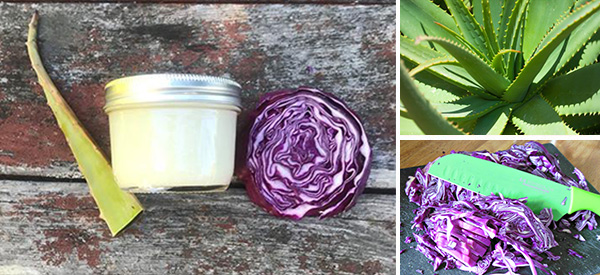
How to Make a Healing Salve with Cabbage and Aloe Vera
One of the healthiest vegetables to add to your diet, cabbage is a member of the Brassica family, which also includes our friends broccoli, cauliflower, and kale. Cabbage has many superpowers. When cabbage is taken internally as a raw juice, cabbage is known to be a fountain of youth for the skin with loads of vitamin C and antioxidants. Cabbage also assists in detoxifying the body which results in weight loss. This recipe combines the healing properties of cabbage and aloe vera to make a spectacular anti-inflammatory skin salve. Cabbage contains sulforaphane, a sulfur compound with strong anti-inflammatory abilities when applied to skin. This brings in our succulent superstar, Aloe Vera.
Aloe Vera, an aloe from the broad Liliaceae family, is most well-known for being able to fight some of the most common inflammation, the sunburn. Aloe is also known for soothing acne scars and blemishes. Combining these two powerful plants together, we will create a fabulous healing salve to soothe inflammation, burns, rashes or common redness on the skin.
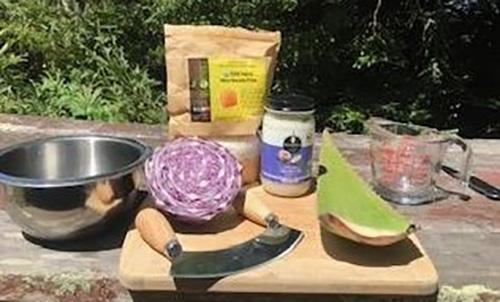
Supplies needed
- ½ cup beeswax pastilles (add more beeswax to make the salve thicker)
- Double boiler- a pot filled ¼ with water and a metal bowl to put inside the pot so the herbs down burn
- 2 cups finely chopped small red or white cabbage (most cabbage salves are made of red cabbage)
- 3 tbsp fresh aloe vera leaf gel
- Cutting board
- Knife (I use a small sharp knife and a french herb chopper)
- 2 cups of hard coconut oil (softened should be about 1 cup)
- 1 8oz wide mouth mason jar
Directions
1. Infuse Your Oil
Depending on time, you can do a cold infusion or hot oil infusion. This recipe will give directions for a hot infusion. To start, melt the coconut oil using a double boiler method.
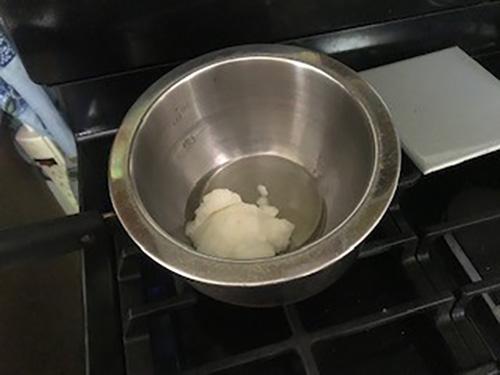
While the coconut oil is melting, cut your medium cabbage into inch-thick size slices and cut one section very finely. It should be about two cups of cabbage.
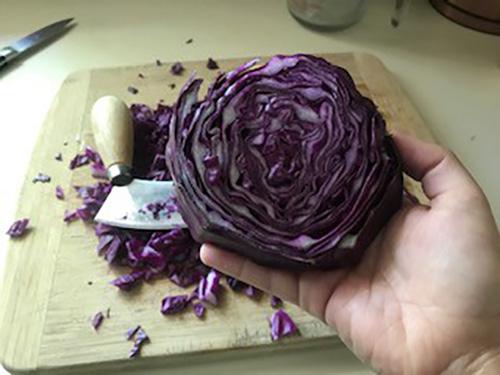
Place the cabbage into the melted coconut oil.
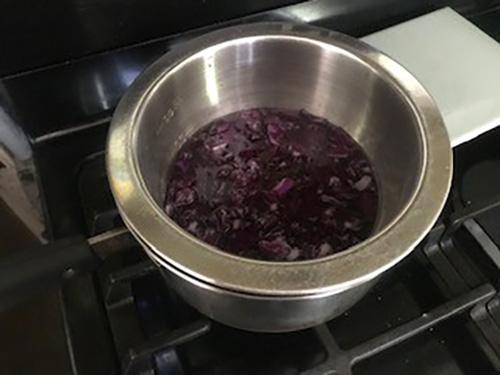
Cover, and heat in a double boiler at low heat for at least 4-5 hours. Check every 45 minutes to an hour to make sure there is still water in the pot so the cabbage does not burn. If needed, add more water.
2. Strain the Cabbage
Turn off the stove. Use a cheesecloth or panty hose to filter out your cabbage from your oil.
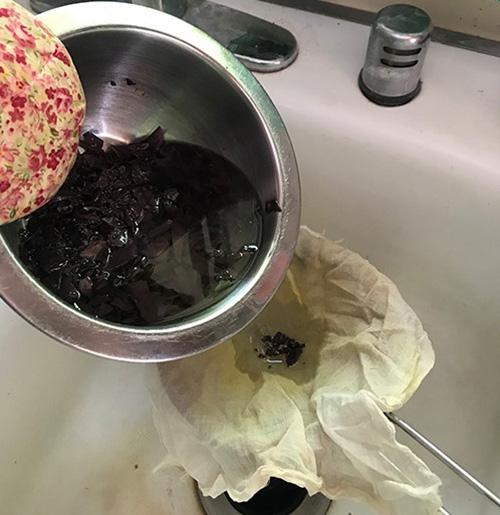
Let cool and then squeeze all of the excess oil out of the cabbage in a measuring cup. Purple liquid should come out and sink to the bottom, separating with the oil.
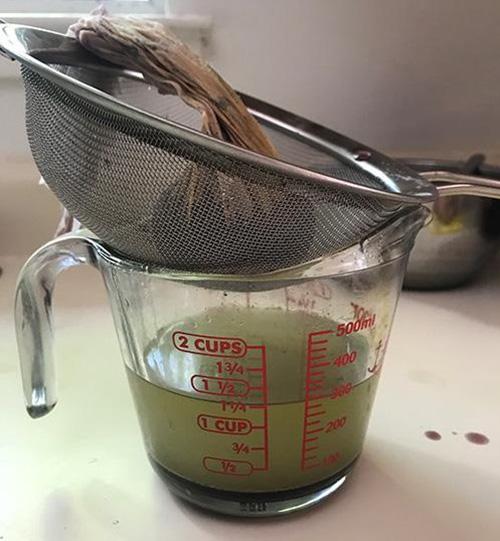
Pour cabbage infused coconut oil into a measuring cup, doing your best to avoid the water based purple juice, back into your bowl you used doing the double boiler method. You should have one cup of infused oil. Discard the purple water.
3. Prepare the Aloe Vera
Wash your aloe vera leaf in the sink thoroughly. Be careful because it is prickly! Cut the top 5 inches off your leaf and the bottom 4 inches off your leaf. Cut off the prickly sides too. Cut the aloe like you are fileting a fish, cut off the top layer of the leaf, and put the knife under the gel to get the gel filet out.
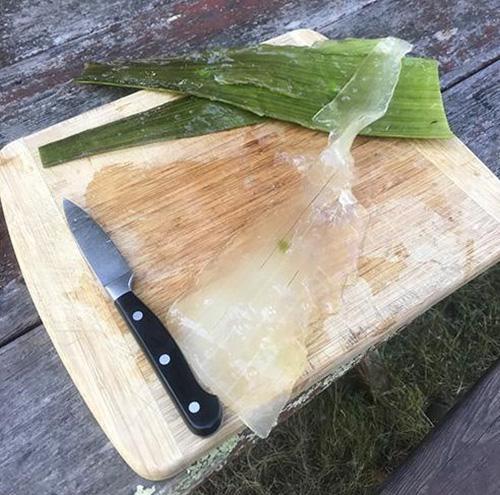
Once the aloe has been extracted, mash with a potato masher in a small bowl. You don’t need more than 2-3 tablespoons of aloe- you can save the rest in the fridge to eat or use later.
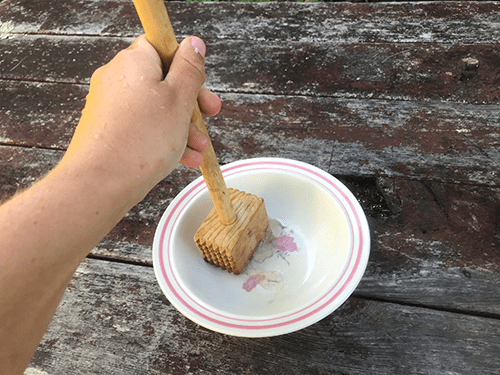
4. Add beeswax
Next, we turn back on the double boiler and add beeswax at our leisure. Usually salves do a 1:4 ratio beeswax to oil. For this I did 1 cup of beeswax pastilles which is a ½ ratio. If you want the salve to be harder, like a balm, add more beeswax. If you want the salve to be softer, with more oil, add less beeswax. I prefer my salves softer, so usually I pour some of my solution into a spoon and let sit to test if the consistency is right. Keep the temperature low and play around. Stir the oil and the beeswax together and let the mixture cool down a bit by taking it off heat. Then add in the aloe vera and stir until dissolved.
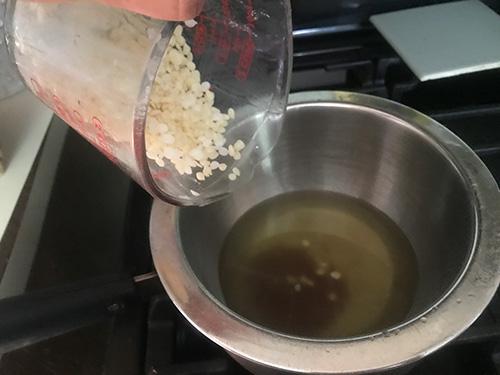
5. Add to Jar
When you have found the right consistency with oil and beeswax, pour into a clean jar.
 Allow the salve to harden and cool.
Allow the salve to harden and cool.

6. Use Away!
Keep your salve in a cool location, and cure your inflammation with this fabulous cabbage and aloe vera salve that we have made today! Keep for no longer than one year. Keep in mind, this salve does smell strongly of cabbage, but it has an INSTANT soothing effect. You can put the salve on anywhere externally, but please do a skin test before to see how your skin reacts, especially on your face.
You may also like:
How To Make Tea Tree Oil To Treat Infections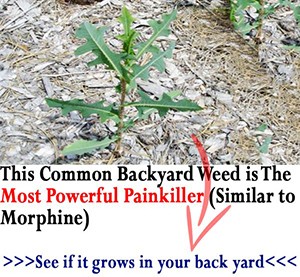
The 10 Medicinal Seeds You Should Plant for a Complete Backyard Pharmacy (video)
43 Remedies from My Childhood that Still Work Today
If You See This Weed Growing In Your Yard, Don’t Pick It – Here’s Why
How To Make Calcium Supplements from Eggshells








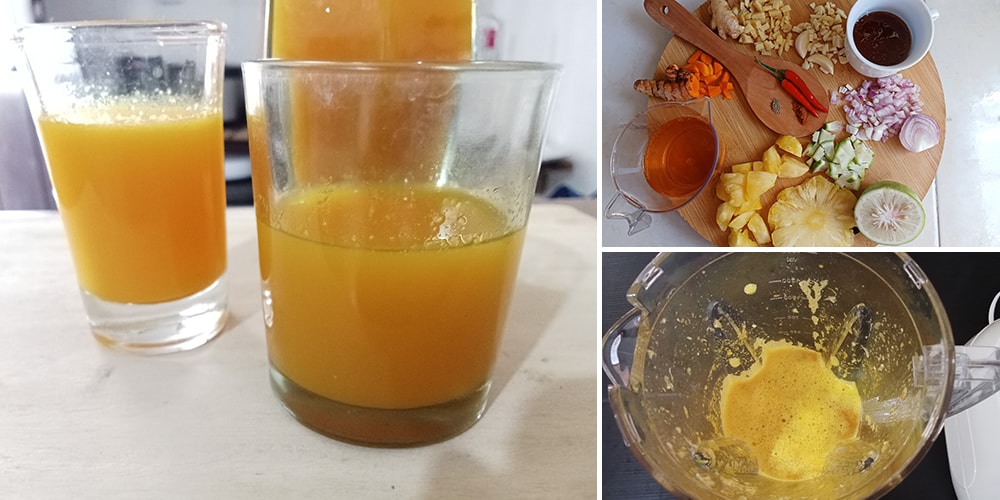
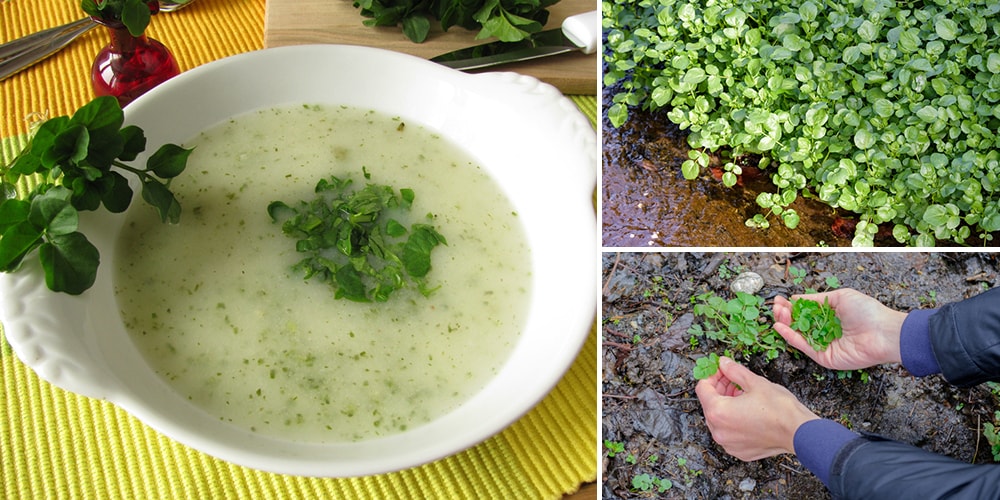
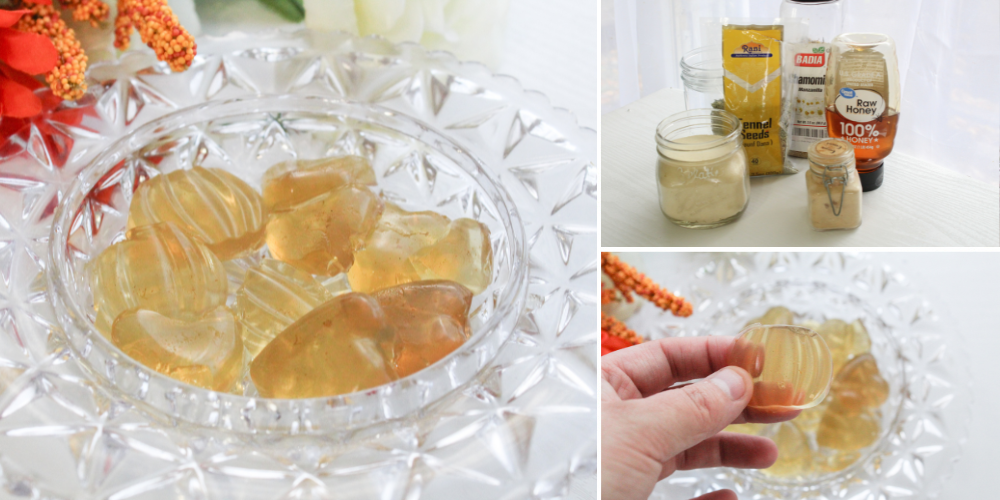
So, we add aloe vera raw? It doesn’t have to be slow cooked also?
I know a lot about Aloe, if you cook it it will lose all of its healing properties,so don’t cook it! Many of the healing properties are gone after about 14 hrs after you cut the leaf. I eat it fresh or in a smoothie to detox my body.
Can I use olive oil instead of coconut oil? Would we add more beeswax to stiffen it?
Hi Jackie,
Various oils can be used to make your herbal infusion, including olive, sesame, sunflower, coconut, sweet almond, and other skin care oils. The consistency of your salve can be adjusted, based on the ratio of ingredients. For a harder salve, add more beeswax; for a softer salve, add more oil.
To test for consistency, remove 1 teaspoon of the oil/beeswax mixture and blow on it or refrigerate it until it hardens. Test with your finger.
God bless!
Dear Nicole am suffering from urethritis, is there a herb that may help take away the inflamation from the urethra ,
I have found corn silk tea is effective against the burning sensation of a UTI.
I boil 4 cups of water, then take it off the stove and place the silk (hairs) of 4 corn cobs in the water to steep for 15 minutes. then drink away – I find relief within the hour.
Hi Rosemary,
Thank you so much for your comment. For Urethra inflammation you can use Bearberry, Couch Grass or Pipsissewa.
God bless!
Is this salve good for soothing and getting rid of poison ivy rash? It seems that my son has it consistently throughout every summer and we eventually end up at urgent care getting a steroid shot when none of the topicals provide relief.
Hi Kathy,
Thank you so much for your comment.
This salve is beneficial for poison ivy rash indeed!
God bless!
Would this also work for mosquito bites and bee sting relief? Also, would it be detrimental to use an immersion blender to add air to salve?
Do you use yellow or white beeswax? My concern with white is that it is chemically processed. I did read some reviews which stated it had a chemical smell. Is there a brand you would recommend? Thank you
Hi Roni,
Thank you so much for your comment.
I advise you to use yellow beeswax.
Here is a purchase link for organic yellow beeswax:
https://www.amazon.com/US-Organic-Beeswax-Pastilles-Certified/dp/B01M1F25QM/ref=sr_1_1_sspa?dchild=1&keywords=yellow+beeswax&qid=1593603224&sr=8-1-spons&psc=1&spLa=ZW5jcnlwdGVkUXVhbGlmaWVyPUEyT045STVCWVpFV1UwJmVuY3J5cHRlZElkPUEwODM2Mzk4MldGOEJJM1JMN0VRNiZlbmNyeXB0ZWRBZElkPUEwMjk0MTA3Mk1BTEo3S0hXWVVPVyZ3aWRnZXROYW1lPXNwX2F0ZiZhY3Rpb249Y2xpY2tSZWRpcmVjdCZkb05vdExvZ0NsaWNrPXRydWU=
God bless!
No need to discard the purple juice of the red cabbage as this makes a beautiful “Natural” dye that can be used in various yarns, fibers and even clothing.
Hi Julia,
Thank you so much for your comment.
We appreciate that you shared this information with us.
God bless!
[…] How to Make a Healing Salve with Cabbage and Aloe Vera […]
[…] How to Make a Healing Salve with Cabbage and Aloe Vera […]
I tried the cabbage/aloe oil. The issue is the aloe is water based and does not stay mixed with the oils so I have the aloe liquid leaking out of the salve.
can I add peppermint oil to help the smell of the cabbage
Something that is seldom mentioned about sulforaphane is it takes time for the plant to make it. I cut up all my veggies now and let them sit for at Least twenty minutes. And because of this article I will now steam lightly and not nuke them, when possible. There is a lot more sulforaphane in broccoli sprouts, I think it’s about thirty times.
Here is a list of the main vegetables that have sulforaphane.
Broccoli
Cauliflower
Brussel sprouts
Kohlrabi
Cabbage
Kale
There is more info here Sulforaphane: Benefits, Side Effects, and Food Sources (healthline.com)
Hi can you make this salve in a slow cooker instead of a double boiler?
what oil can i use to ad to the cabbage sauve to make it smell better
[…] How to Make a Healing Salve with Cabbage and Aloe Vera […]